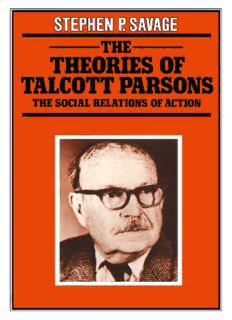
The Theories of Talcott Parsons: The Social Relations of Action PDF
Preview The Theories of Talcott Parsons: The Social Relations of Action
THE THEORIES OF TALCOTT PARSONS THE THEORIES OF TALCOTT PARSONS The Social Relations of Action Stephen P. Savage M MACMILLAN PRESS LONOON © Stephen P. Savage 1981 All rights reserved. No part of this publication may be reproduced or transmitted, in any form or by any means, without permission First edition 1981 Reprinted 1983 Published by THE MACMILLAN PRESS L TD London and Basingstoke Companies and representatives throughout the world ISBN 978-0-333-36165-8 ISBN 978-1-349-06969-9 (eBook) DOI 10.1007/978-1-349-06969-9 To my Parents Contents Acknowledgements IX List of Abbreviations x Introduction Xl 1 Modes of Critique and the Theoretical Analysis of Discourse 1 1.1 Introduction 1 1.2 The Subject of Discourse as the Object of Critique 5 1.3 The Realist Mode of Critique 10 1.4 Epistemological Modes of Critique 16 1.5 Parsons' Mode of Reading in The Structure of Social Action: the Proof of the Validity of the Action Frame of Reference 24 1.6 Internal Modes of Critique 30 (i) Modes of Internal Critique of Parsons 31 (ii) The Althusserian Project for a Theory of Theoretical Production 48 1.7 Conclusion: the Concepts for the Analysis of Discourse 57 2 The Epistemology of 'Analytical Realism' 62 2.1 Analytical Realism: Anti-Empiricism and Anti- Fictionalism 64 2.2 The Theoretical Component of Analytical Realism 82 2.3 The 'Reality' Component of Analytical Realism 87 2.4 Conclusion 90 3 The Structure of Action: Parsons' Formulation of the Action Frame of Reference 91 3.1 Introduction 91 3.2 The 'Voluntaristic' Nature of Action: the Role of Free-will and Subjectivity 94 3.3 Action as Meaningful Behaviour: the Role of Values 105 vii Vlll Contents (i) The Concept of Values: Indeterminacy at the Level of Culture 106 (ii) The Symbolic Level of Culture and its Realis- ation in Action: Indeterminacy of Effectivity 111 3.4 Action as the Relation between the Ideational and Natural: Idealism and Contradiction 116 4 Action and the 'Three Systems of Action': the Con- cept of Social Relations 128 4.1 Introduction 128 4.2 Action and 'Systems of Action' 128 4.3 Psychologism and 'Methodological Individualism' 132 4.4 Merton's 'Functional Paradigm' and 'Factor' Theories of Social Phenomena 138 4.5 Parsons' Theory of the Social System 145 (i) The Concept of Power 147 (ii) The Social System and its Conditions of Exist- ence: the Personality and Cultural Systems 154 5 The Economy and the Social System 166 5.1 Economic Theory and Sociology 167 5.2 The Economy, 'Action' and the Theory of Social Systems 172 5.3 The Concept of Structural Differentiation 179 5.4 The Concept of Functional Subsystems 188 5.5 Conclusion 195 6 The Theory of Social Change and Social Evolution 196 6.1 Social Change and Structural-Functionalism 197 6.2 The Development of the Theory of Social Change 199 6.3 Social Change as Social Evolution 208 6.4 Parsons and Darwinism 218 6.5 Social Evolution as Teleology 222 6.6 Religion, Culture and Social Evolution 226 Conclusion 234 Notes 236 Bibliography 251 Index 275 Acknowledgements I would like to offer special thanks to Barry Hindess for his help prior to and throughout this work, and to all the others who have given useful comments on the various chapters. Thanks also to my wife, Carol, for her encouragement and help with typing the manuscripts. ix List of Abbreviations In the following chapters a number of references to Parsons' work have been abbreviated. They refer to the following texts: SSA The Structure of Social Action Essays Essays in Sociological Theory TGTA Toward a General Theory of Action SS The Social System WPTA Working Papers in the Theory of Action ES Economy and Society TS Theories of Society STMS Sociological Theory and Modern Society Societies Societies: Evolutionary and Comparative Perspectives SMS The System of Modern Societies PSS Politics and Social Structure x Introduction The chapters that follow constitute an attempt to develop a theoretical reading and critique of the work of Talcott Parsons. For all the acknowledgements regarding Parsons' apparent influence on contemporary (particularly American) sociology, there have been surprisingly few serious attempts to explain the mechanisms of Parsonian analysis. There have been even fewer theoretically-effective critical analyses of Parsons' work, and all too often critical commentaries have resorted to glib dismissal and uninformed polemic. This work aims to go some way to alleviating such a state of affairs. Three areas of necessary investigation stem from this objective. To begin with, some assessment of the achievements of existing criticisms of Parsoni an theory must be made. Does, for example, the label 'consensus theorist' and its attendant accusations find support in the actualities of structural-functionalism? Is the claim that Parsonian theory effectively rules out any considera- tion of social change, conflict and deviance substantiable? These are questions which must be decisively approached. The second area of investigation follows on quite closely from the first one. No critical analysis of Parsons' work can ignore the relationship between his work and other major theoretical attempts to conceptualise the respective areas of investigation. Does Parsons, in fact, develop a distinct mode of social analysis or is his theory, as has been implied by some, a mishmash of earlier (incompatible) positions? In the arguments advanced in this volume comparisons between Parsons' theses and both early and subsequent sociological theories are made wherever applicable. The third, and most important, objective is to present a theoretical reading of the primary concepts of Parsonian theory and to offer a number of criticisms which, it is argued, reflect severe theoretical shortcomings. In order to achieve this I have broken Parsons' work down according to the major areas of his theory - the epistemology of analytical realism, the 'action' xi
